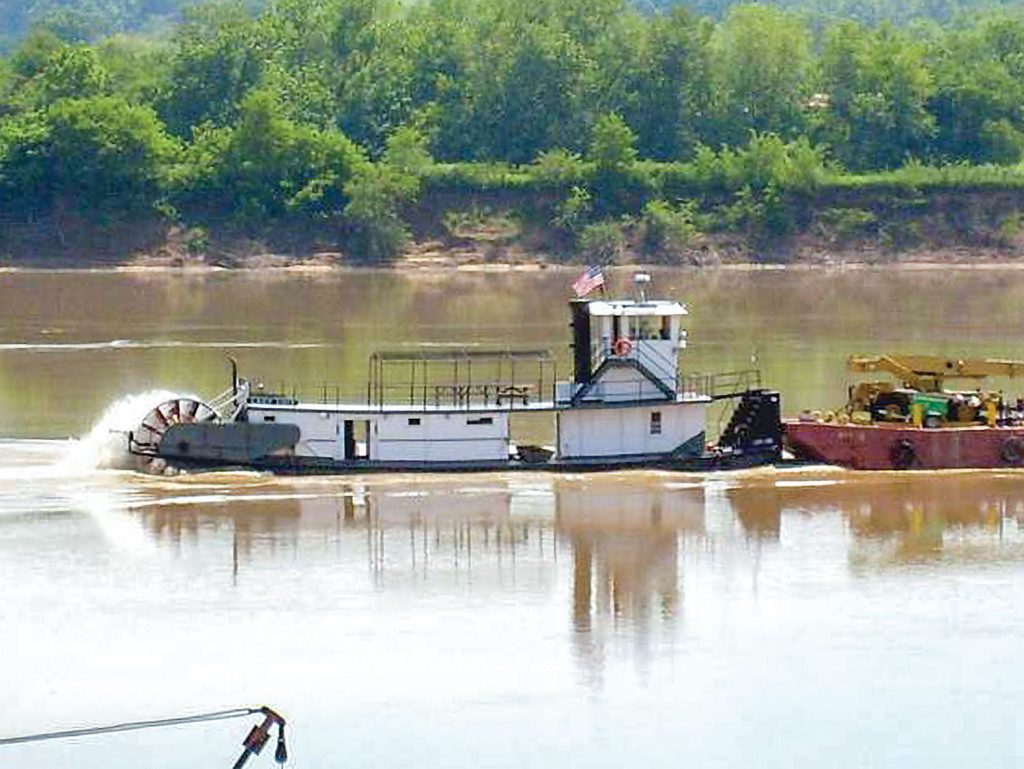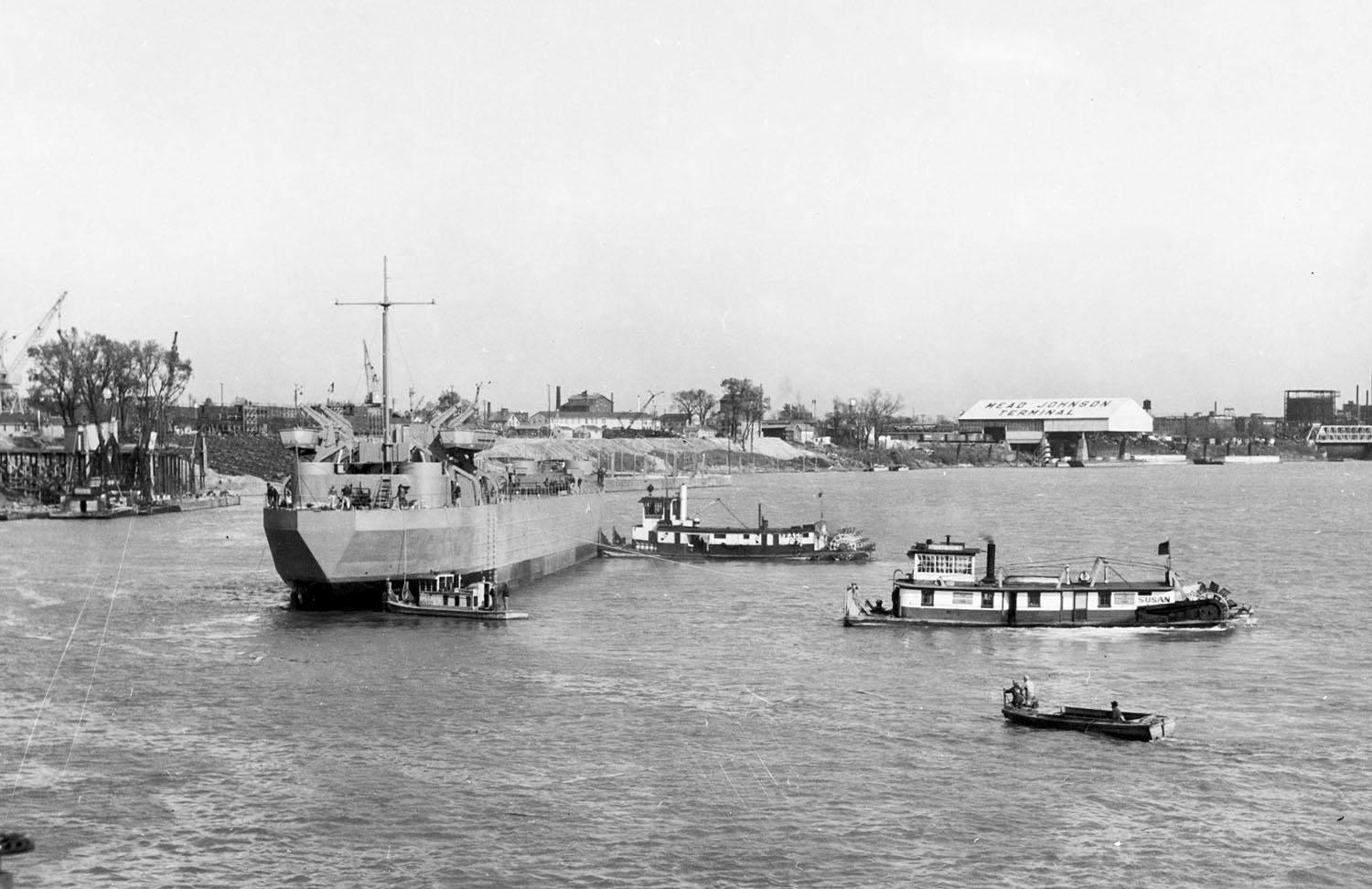This column is being written as we observe Memorial Day and remember those who gave their lives in service to our country. A photo recently shared with me prompted the column and is interesting on many levels.
The Missouri Valley Bridge & Iron Company was formed at Leavenworth, Kan., in 1874. It was instrumental in building bridges throughout the country, including the bridge over the Upper Mississippi River at Cairo, Ill., that was erected in 1929. At the beginning of World War II, the firm opened two shipyards, one at the headquarters location of Leavenworth on the Missouri River, and the other on the Ohio River at Evansville, Ind.
While the Leavenworth yard built smaller craft such as LCTs for the war effort, the Evansville yard would build larger vessels and ultimately turned out some 171 LSTs (Landing Ship, Tank) before closing in 1945. Because of this, Evansville was selected in 2000 as the home port for LST 325, the last remaining WW II era LST. Though LST-325 was built at Philadelphia, the history of the Evansville yard made that city a prime location for the vessel that serves as a museum there, but still makes calls at river cities where it is open to the public as well.
In the first photo, LST-157, the first completed by Missouri Valley Bridge & Iron at Evansville, has been launched in late 1942 and is being corralled by the sternwheelers Graco and Susan. LST-157 would go on to serve in the European theater, and it participated in the landings at Sicily and Salerno, Italy, and the Normandy invasion. It was transferred to the United Kingdom in December 1944 and returned to the U.S. in June 1946. It was sold for scrapping in 1947.
In addition to Evansville, these LSTs were built at the inland yards of Dravo at Neville Island, Pa.; American Bridge Company at Ambridge, Pa.; JeffBoat at New Albany, Ind.; and the Chicago Bridge & Iron Company at Seneca, Ill., some 580 in all. After having them built, the government had the problem of getting them delivered to the Gulf Coast. The late Jim Swift detailed the solution to this in his book “Backing Hard Into River History.” Experienced river pilots were inducted into the Coast Guard and tasked with piloting these craft to blue water. These men were dubbed the “Catfish Navy.” I was privileged to know several, including Capts. Bert Shearer, Joe McKee, C.W. Stoll and Roy L. Barkhau. While not aboard as a pilot, Jim Bupp of Charleston, W.Va., now 98 and well known to many rivermen on the Upper Ohio and Kanawha rivers, served aboard LSTs as a seaman in the Navy during the conflict.
The sternwheel towboat in the foreground is the Susan. The Inland River Record has very little information about it other than it was built at Henderson, Ky., in 1929, had a wood hull 64.8 by 16 feet and had a Fairbanks-Morse diesel of 120 hp. The IRR shows it as owned by W.C. Cooper of Henderson. The List of US Merchant Vessels (List) has it owned by a W.C. “Copper” through 1945, and then by Katherine K. Cooper until 1955, when the IRR shows it as dismantled, and the hull sold. This image shows it as a trim little boat with a large steamboat-style pilothouse.
The other sternwheel boat is the Graco. It was built by the Nashville Bridge Company (Nabrico), Nashville, Tenn., in 1928 as the Catharine D and had a steel hull that was 74 by 18 feet (100 by 20 overall). The original power was supplied by a Fairbanks-Morse five-cylinder diesel of 200 hp. While the IRR has always shown it as originally owned by Alpha Portland Cement, St. Louis, the List indicates that as the Catherine D it was owned by Nabrico until 1932, when it was owned by Alpha and renamed C.A. Irvin. As seen in the photo, this sternwheeler had a somewhat more modern profile, with the pilothouse sitting well forward and over the engine compartment. There was a breezeway behind that and then crew quarters, galley and gear room.
In 1936, the boat was sold to the Bedford-Nugent Company in Evansville and renamed Graco. In 1949, it was repowered with an F-M 6-cylinder diesel engine of 210 hp. at 720 rpm., and fitted with a 2:1 reduction gear. In 1962, the owning firm became Evansville Materials Company. In 1969, it was again repowered, this time with a GM 6-110 diesel of 300 hp. The boat was a fixture in the Evansville area, moving sand and gravel barges until it was sold in September 1973 to Three States Towing Inc., Panama City, Fla. In October 1975, it was sold to Jacobs Towing Company, Louisville, and brought back to the Ohio River.
On the night of December 8, 1975, the Graco was pushing the towboat Herman K upbound on the Ohio when Capt. Robert F. Jacobs, the owner and master, was reported missing in the vicinity of Vevay, Ind. Our favorite archivist, Capt. Jeff Yates, saved a story from the December 13, 1975, issue of The Waterways Journal that says the Coast Guard was still searching for the body. The Graco was tied off at Russell, Ky., for some time after this and in August 1976 it was sold to Merdie Boggs & Sons Inc., Catlettsburg, Ky. It was renamed Lady Lois and was often in attendance at area sternwheel regattas. It was leased to Warner Brothers for filming the TV series “Mississippi” starring Ralph Waite from 1982–1983. The boat was renamed John W. Stone and Mississippi during this time for film purposes only.

In December 1996 the Lady Lois was sold to Madison Coal & Supply Company, Charleston, W.Va., now Amherst Madison. It was extensively rebuilt with a replated hull and raised pilothouse. In 1997 it was repowered with a GM 12v71 engine of 400 hp., and in 2000 it was again repowered with a GM Series 60 diesel of 500 hp. with a Twin Disc 3:1 gear. The boat was utilized in the construction division of the company, and it continues that service today. It was often seen at Tall Stacks and regatta events shepherding the whistle barge Anna Marie.
Caption for top photo: LST 157 launch at Evansville in 1942. (Evansville Shipyard Collection, Evansville Museum photo)
Capt. David Smith can be contacted at davidsmith1955obc@gmail.com.



